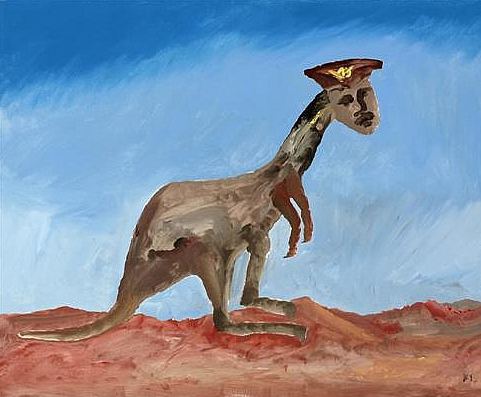|
- 98
-
But
Nolan's kangaroo was no ordinary Australian marsupial.
He was no "Skippy".
Nolan portrayed this kangaroo in a slightly reptilian
aspect - a sort of small dinosaur, with "paws"
caked up to its armpits in what appears to be dried blood.

Nolan's "Kangaroo" - note what seems
to be caked blood
on the creature's paws and forearms
|
This reptilian
creature is wearing what looks like an Air Force officer's
hat, its human shield-like face twisted awkwardly towards
the viewer.
Given the circumstances of the composition of this final
"Kangaroo series" painting, it is difficult
to avoid its identification with Patrick White...
...who has now become, in Nolan's eyes, the fascist
leader out of Lawrence's Australian novel.
[RD adds: in fact, the identification may be more pertinent
than even Nolan realised, for Patrick White's family,
the Whites of Belltrees - as Andrew Moore's research
has revealed - were active in the 1930-32 Old Guard,
and 10 years earlier had been almost certainly involved
with the country section of Rosenthal's King and Empire
Alliance, and thus Jack Scott's secret army, "the
garage".]
The
luminaries in Australia's cultural pantheon who have been
influence by Lawrence and Kangaroo cannot be fully
plumbed here. Indeed, I cannot make up a definitive list.
However, Tom Bass - Australia's greatest sculptor - must
be mentioned.
Bass, who died in 2010, called Lawrence "my inspiration,
my mentor, my guide".
It was Lawrence's poetry that first attracted him. "Lawrence
spoke to me directly. I can't think of any other man who
has been on my life's journey with me as intimately and
constantly as Lawrence," he said in an interview
published in Rananim in 2004.
In 1974, one of Lawrence's poems "The Story of the
Man Who Has Come Through" inspired Bass to cast a
Lawrentian bronze, which he named "Introspection".
"I
was especially affected by that poem," he said. "It
was particularly important to me at a time when it seemed
that almost every aspect of my life and my values were
crumbling. I felt that my whole sense of myself and my
career had been invalidated. I felt like a medieval man
stranded in the middle of the 20th century.
"Then, when I read Lawrence's lines that there is
"the fine, fine wind that finds its way through the
chaos of the world" and that he would be "like
a fine, an exquisite chisel, a wedge-blade inserted driven
by invisible blows, the rock will split, and we shall
come at the wonder" I felt he was speaking to me
as a sculptor."

|
|